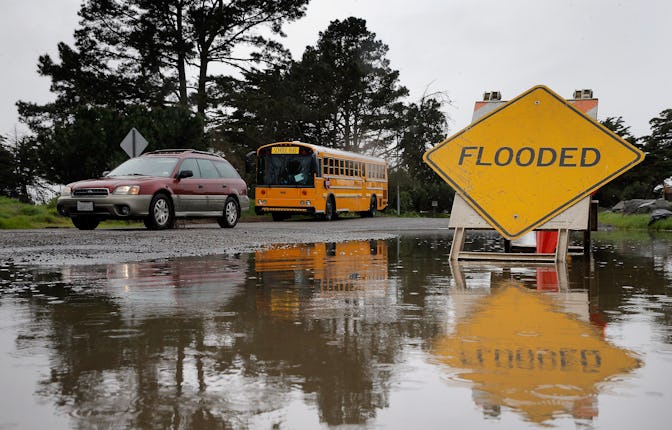California is due for a “megaflood,” per a new study
Wondering how a drought-stricken state can be at risk for too much rain? Allow us to explain.

California and much of the West Coast have been stuck in the middle of a historic drought — the worst the region has experienced in more than a millennium. Given the devastation from this ongoing dry spell, it seems odd to think that a major concern for the West would be “too much rain.” But a new study published in the journal Science Advances warns that California is at risk of getting hit with a “megaflood” that could prove to be disastrous, both for Californians and for the nation as a whole.
Here’s the expectation for the deeply disruptive and destabilizing event, which has garnered quite a bit of attention: It’ll start in the Pacific Ocean during winter, where currents will carry warm tropical air to the California coast. It’ll build steam along the way, growing, like a massive water balloon just waiting to pop. And then it’ll do just that, as California’s mountainous southern coast pushes the moist air higher and higher until it finally discharges, unloading as much as 100 inches of rainwater on the state.
As that water comes pouring down, possibly for a month or longer, it will flood millions of people. Researchers warn that the Sacramento and San Joaquin Valleys will turn into temporary inland seas that stretch for 300 miles. Meanwhile, Los Angeles and Orange Counties will be inundated with water — as much as 2 inches per hour.
What the rain doesn’t bury, the runoff will, with snow accumulating on mountains and rain on hillsides pushing debris down into the lower lying areas many people call home. And there is a lot of debris in California right now, because of wildfires that have burned out major swaths of land and killed off the roots of lots of trees and other plants, making them easily swept away by the storm. Stockton, Fresno, and Los Angeles would wind up underwater, the researchers say, with millions of people pushed from their homes and an estimated $1 trillion in damage done.
To see this scenario turn into a reality would be perhaps the worst direct impact of climate change yet — and there is little doubt that climate change would be responsible should this come to pass. The researchers warn that the likelihood of this megaflood scenario has doubled in the last decade. What does that mean, exactly? Under normal conditions, a megaflood is a once-in-a-generation event, sometimes called a 100-year storm. That doesn’t mean it’s guaranteed to happen once every 100 years, but rather there is a 1% chance of it happening in any given year. Those odds for this megaflooding of California, according to the study, have doubled. That means the odds of the megaflood happening over the next four decades is now 1 in 50 during any given year during that period.
Those odds of the event happening improve — i.e., the storm gets more likely — as the planet warms. The researchers warn that if the planet were to warm another 1 degree Celsius, the odds of this megaflood would jump to 1 in 30. Currently, we are on pace to experience at least another full degree temperature rise, as current policies designed to address climate change fail to limit the overall warming to below the 2 degree Celsius threshold established by the Paris Climate Agreement.
The damage done by such a storm is also worse because of the ongoing effects of climate change. The dry conditions that California is currently experiencing — and has been for some time now — is at least in part responsible for the record-setting wildfires that have plagued the state in the last decade. Those fires have created lots of debris — dead trees, branches, dried-out bushes, and the like — that will inevitably get swept up in raging floodwaters and cause more damage than the water would alone.
A megaflood like the one these researchers warn about would require the perfect storm — the coming together of a number of unlikely conditions all at once in order to produce the utmost devastation and worst-case scenario. But some of those unlikely conditions have already been met. And every year that passes that we don’t seriously set about addressing climate change is another year where the odds of a generational disaster gets more likely.